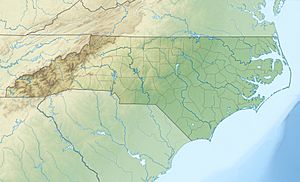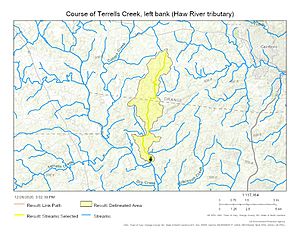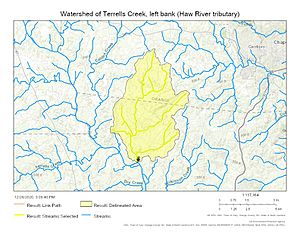Terrells Creek (Haw River tributary, left bank) facts for kids
Quick facts for kids Terrells Creek |
|
|---|---|
|
Location of Terrells Creek mouth
|
|
| Other name(s) | Tributary to Haw River, left bank |
| Country | United States |
| State | North Carolina |
| Counties | Chatham Orange |
| Physical characteristics | |
| Main source | divide between Terrell Creek and Collins Creek about 1 mile southeast of White Cross, North Carolina 580 ft (180 m) 35°54′26″N 079°10′49″W / 35.90722°N 79.18028°W |
| River mouth | Haw River about 4 miles northwest of Bynum, North Carolina 357 ft (109 m) 35°49′17″N 079°11′25″W / 35.82139°N 79.19028°W |
| Length | 7.44 mi (11.97 km) |
| Basin features | |
| Progression | south |
| River system | Haw River |
| Basin size | 15.91 square miles (41.2 km2) |
| Tributaries |
|
| Bridges | Old Greensboro Road, Crawford Dairy Road, River Road |
Terrells Creek is a small stream, about 7.44 mi (11.97 km) long, located in North Carolina, United States. It flows into the Haw River. Terrells Creek is known as a "3rd order tributary," which means it's a stream that has other smaller streams (first and second order) flowing into it before it joins a larger river. It flows through Chatham and Orange counties.
Contents
What is Terrells Creek?
Terrells Creek is a natural waterway that helps carry water from the land into the larger Haw River. It plays an important role in the local environment.
Other Names for the Creek
Over time, Terrells Creek has been known by a few different names. These include:
- Ferrell Creek
- Ferrells Creek
- Tyrrells Creek
Where Does Terrells Creek Flow?
Terrells Creek begins its journey about 1 mile southeast of a place called White Cross, North Carolina. This starting point is in Orange County. From there, the creek flows south.
It then enters Chatham County. Finally, it reaches the Haw River. This meeting point is about 4 miles upstream from a town called Bynum.
The Terrells Creek Area
The area that Terrells Creek drains, called its watershed, covers about 15.91 square miles (41.2 km2). A watershed is like a big bowl where all the rain and snow that falls eventually flows into a specific river or creek.
This area gets about 47.6 inches of rain each year. A large part of the watershed, about 77%, is covered by forests. This means there are many trees and plants that help keep the water clean and provide homes for wildlife.





